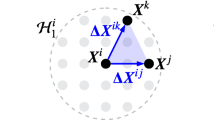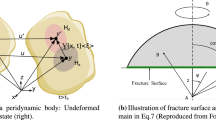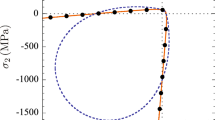Abstract
A puzzling question in dynamic fracture has been why cracks in amorphous brittle materials always travel at velocities smaller than the Rayleigh wave speed. The answer is that the energy per length needed for the crack to propagate depends strongly on velocity. As the energy flux to the crack tip increases, the crack chooses new modes of dissipation such as micro-cracking and the creation of subsurface damage zones to dissipate this energy. In this paper we use a potential drop technique to measure length and velocity of a crack with high spatial precision and time resolution so as to investigate the modes of dissipation in Homalite-100 and make qualitative comparisons with PMMA. The technique is capable of resolving crack initiation, run, and arrest. Using this technique we search for a 'forbidden band' of velocities in PMMA, Homalite-100, and glass, and we show that no such velocity gap exists in these amorphous materials at room temperature.
Similar content being viewed by others
References
Abraham, F.F., Brodbeck, D., Rafey, R.A. and Rudge, W.E. (1994). Instability dynamics of fracture: A computer simulation investigation. Physical Review Letters 73(2), 272–275.
Béguelin, P., Stalder, B. and Kausch, H.H. (1983). Application of a new velocity gage to fracture at high velocities. International Journal of Fracture 23, R7–R10.
Buck, O. (1989). Recent advances in fracture mechanics testing. In Fracture Mechanics: Microstructure andMicromechanisms. (Edited by S.V. Nair, J.K. Tien, R.C. Bates, and O. Buck) ASM International, Metals Park, OH, 31–86.
Cotterell, B. (1965). Velocity effects in fracture propagation. Applied Materials Research 4, 227–232.
Cudré-Mauroux, N., Kausch, H.H., Cantwell, W.J. and Roulin-Moloney, A.C. (1991). High speed crack propagation in bi-phase materials: An experimental study. International Journal of Fracture 50, 67–77.
Dally, J.W. (1979). Dynamic photoelastic studies of fracture. Experimental Mechanics 19, 349–361.
Doyle, M. A mechanism of crack branching in polymethylmethacrylate and the origin of bands on the surface of fracture. Journal of Materials Science 18, 687–702.
Dulaney, E.N. and Brace, W.F. (1960). Velocity behavior of a growing crack. Journal of Applied Physics 31, 2233–2266.
Field, J.E. (1971). Brittle fracture: its study and application. Contemporary Physics 12, 1–31.
Fineberg, J., Gross, S.P., Marder, M.P. and Swinney, H.L. (1991). Instability in dynamic fracture. Physical ReviewLetters 67, 457–460.
Fineberg, J., Gross, S.P., Marder, M.P. and Swinney, H.L. (1992). Instability in the propagation of fact crack. Physical Review B 45, 5146–5154.
Freund, L.B. (1990). Dynamic Fracture Mechanics. Cambridge University Press, New York.
Gilman J.J., Knudsen, C. and Walsh, W.P. (1958). Cleavage cracks and dislocations in LiF crystals. Journal ofApplied Physics 6, 601–607.
Griffith, A.A. (1920). The phenomena of rupture and flow in solids. Mechanical Engineering A221, 163–198.
Gross, S.P. Fineberg, J., Marder, M.P., McCormick, W.D. and Swinney, H.L. (1993). Acoustic emissions from rapidly moving cracks. Physical Review Letters 71(19), 3162–3165.
Gumbsch, P. (1995). An atomistic study of brittle fracture: Toward explicit failure criteria from atomistic modeling. Journal of Materials Research 10(11), 2897–2907.
Hall, E.O. (1953). The brittle fracture of metals. Journal Mechanics and Physics Solids 1, 227–233.
Hull, D. and Beardmore, P. (1966). Velocity of propagation of cleavage cracks in tungsten. International Journalof Fracture Mechanics 2, 468–487.
Irwin, G.R., Dally, J.W., Kobayashi, T., Fourney, W.L., Etheridge, M.J. and Rossmanith, H.P. (1979). On the determination of the a-k relationship for birefringent polymers. Experimental Mechanics 19(4), 121–128.
Kalthoff, J.F., Beinert, J. and Winkler, S. (1977). Measurements of dynamic stress intensity factors for fast running cracks in double-cantilever-beam specimens. In Fast Fracture and Crack Arrest (Edited by G.T. Hahn and M.F. Kanninen) ASTM STP 627, 161–176.
Kerkhof, F. (1973). Wave fractographic investigations of brittle fracture dynamics. In Dynamic Crack Propagation(Edited by G.C. Sih) Noordhoff International Publishing, Leyden, 3–29.
Knauss, W.G. and Ravi-Chandar, K. (1985). Some basic problems in stress wave dominated fracture. InternationalJournal of Fracture 27, 127–143.
Kobayashi, T. and Dally, J.W. (1977). Relation between crack velocity and the stress intensity factor in birefringent polymers. In Fast Fracture and Crack Arrest (Edited by G.T. Hahn and M.F. Kanninen) ASTMSTP 627, 7–18.
Kobayashi, A.S. and Mall, S. (1978). Dynamic fracture toughness of Homaltie-100. Experimental Mechanics 18(1), 11–18.
Kobayashi, A., Ohtani, N. and Sato, T. (1974). Phenomenological aspects of viscoelastic crack propagation. Journal of Applied Polymer Science 18, 1625–1638.
Liu, X. and Marder, M.P. (1991). The energy of a steady-state crack in a strip. Journal of Mechanics and PhysicsSolids 39, 947–961.
Marder, M.P. (1993). Simple models of rapid fracture. Physica D 66, 125–134.
Marder, M.P. and Gross, S.P. (1995). Origin of crack tip instabilities. Journal of Mechanics and Physics of Solids 43, 1–48.
Marder, M.P. and Liu, X. (1993). Instability in Lattice fracture. Physical Review Letters 71, 2417–2420.
Mott, N.F. (1947). Brittle fracture in mild steel plates. Engineering 165, 16–18.
Ravi-Chandar, K. and Knauss, W.G. (1982). Dynamic crack-tip stress under stress wave loading-a comparison of theory and experiment. International Journal of Fracture 20, 209–222.
Ravi-Chandar, K. and Knauss, W.G. (1984a). An experimental investigation into dynamic fracture: I. Crack initiation and arrest. International Journal of Fracture 25, 247–262.
Ravi-Chandar, K. and Knauss, W.G. (1984b). An experimental investigation into dynamic fracture: II. Microstructural aspects. International Journal of Fracture 26, 65–80.
Ravi-Chandar, K. and Knauss, W.G. (1984c). An experimental investigation into dynamic fracture: III. On steadystate crack propagation and crack branching. International Journal of Fracture 26, 141–154.
Ravi-Chandar, K. and Knauss, W.G. (1984d). An experimental investigation into dynamic fracture: IV. On the interaction of stress waves with propagating cracks. International Journal of Fracture 26, 189–200.
Schardin, H., Mucke, L., Struth, W. and Rhein, W.A. (1955). Cracking velocity of glasses. The Glass Industry 36(3), 133–138.
Sharon, E., Gross, S.P. and Fineberg, J. (1995). Local crack branching as a mechanism for instability in dynamic fracture. Physical Review Letters 74, 5146–5154.
Sharon, E., Gross, S.P. and Fineberg, J. (1996). Energy dissipation in dynamic fracture. Physical Review Letters 76(12), 2117–2120.
Sinclair, J.E. and Lawn, B.R. (1972). An atomistic study of cracks in diamond-structure crystals. Proceedings ofthe Royal Society A 329 83–103.
Stalder, B., Béguelin, P. and Kausch, H.H. (1983). A simple velocity gauge for measuring crack growth. International Journal of Fracture 22, R47–R54.
Stalder, B., Béguelin, P., Roulin-Moloney, A.C. and Kausch, H.H. (1989). The graphite gauge and its application to the measurement of crack velocity. Journal of Materials Science 24, 2262–2274.
Stalder, B. and Kausch, H.H. (1985). The use of a velocity gauge in impact testing of polymers. Journal ofMaterials Science 20, 2873–2881.
Stroh, A.N. (1957). A theory of the fracture of metals. Philosophical Magazine 6, 418–465.
Thomson, R., Hsieh, C. and Rana, V. (1971). Lattice trapping of fracture cracks. Journal of Applied Physics 42(8), 3154–3160.
Wang, X.M. and Kim, H.S. (1993). Continuous measurement of crack growth in plastics. Journal of MaterialsScience Letters 12, 357–358.
Weimer, R.J. and Rogers, H.C. (1977). A high-speed digital technique for precision measurement of crack velocities. In Fast Fracture and Crack Arrest (Edited by G.T. Hahn and M.F. Kanninen) ASTM STP 627, 359–371.
Yoffe, E.H. (1951). The moving griffith crack. Philosophical Magazine 42, 739–750.
Zhou, S.J., Carlsson, A.E. and Thomson, R. (1994). Crack blunting effects on dislocation emission from cracks. Physical Review Letters 72 852–855.
Author information
Authors and Affiliations
Rights and permissions
About this article
Cite this article
Hauch, J., Marder, M. Energy Balance in Dynamic Fracture, Investigated by a Potential Drop Technique. International Journal of Fracture 90, 133–151 (1998). https://doi.org/10.1023/A:1007491318198
Issue Date:
DOI: https://doi.org/10.1023/A:1007491318198




